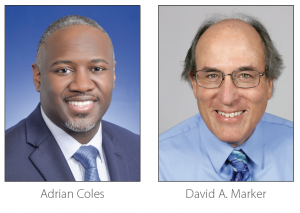Justice, Equity, Diversity, and Inclusion
After the death of George Floyd, many professional organizations confronted the need to issue statements regarding their commitment to justice, equity, diversity, and inclusion (JEDI). I am proud to say that this includes the ASA, and I am privileged to announce the formation of an ASA Anti-Racism Task Force. To help us make progress on the goals outlined in our statement, the task force has been charged with the following:
- Review the association’s infrastructure, policies, and procedures to determine how structural and systemic barriers conflict with the association’s position on justice, equity, diversity, and inclusion. The task force will develop infrastructure and policy recommendations to the board of directors and other senior leaders to help drive positive cultural change within the association that aligns to the association’s stated position on justice, equity, diversity, and inclusion.
- Assess the communications and activities of groups within the association that provide services, benefits, or support to key stakeholders, other professional associations, and the public for the presence and impact of racial and ethnic bias. Examples of communications and activities include, but are not limited to, educational guidance and support, professional development programs, development activities, and public relations campaigns. The task force will develop recommendations to the board of directors and other senior leaders to ensure communications and activities of the association’s groups align with the association’s position on justice, equity, diversity, and inclusion.
- Propose mechanisms to the board through which the association will inform the public on the responsible use of statistics and data science in systems that can unintentionally contribute to widespread racial and ethnic bias in society, such as facial recognition algorithms, predictive policing, and machine learning optimization algorithms, etc. Also propose how statistics should be used to support anti-racist systems.
The co-chairs of the task force are Adrian Coles and David A. Marker. Also serving on the committee are Emma Benn, Emily Lynn Butler, Necip Doganaksoy, Samuel Echevarria-Cruz, Portia Exum, Emily Hadley, Susan Halabi, Ofer Harel, Diane Herz, Monica C. Jackson, Elizabeth Mannshardt, Wendy Martinez, Miles Q. Ott, Roy Dooti, Douglas A. Samuelson, Abdus S. Wahed, Erin A. Wiley, David C. Wilson, Jenny Hang Yang, and Steve Ziliak.
The task force will hold their initial meeting this month, and I want our members and colleagues to know more about their important work so we can all contribute. To begin our community’s conversation, this column will be devoted to an exchange with Adrian and David, ending with a conclusion provided by a surprise guest—Rob Santos, our 2021 ASA president.
Thank you, Adrian and David, for agreeing to hold this conversation, but more importantly for leading the charge. Please start us off by introducing yourselves.
David: I am a senior statistician and associate director at Westat, where I’ve worked for almost my entire career. I have served on the ASA Board of Directors and currently serve as vice chair of the Professional Issues and Visibility Council, which includes our committees focusing outward from the ASA to society. I have been a longtime activist on racial justice, but despite lots of progress, we now see a more determined effort to undermine our future that must be addressed. I have served on our local Human Rights Commission, facilitated anti-Apartheid efforts, and been an expert statistical witness on voter ID cases in federal and state court. I look forward to being a strong advocate and ally for our anti-racist actions.
Adrian: I am a senior research scientist at Eli Lilly and Company. I am also the chair of the Committee on Minorities in Statistics, the associate director for industrial relations for the Math Alliance, and heavily involved in diversity and inclusion efforts within my company. As these roles suggest, I am passionate about creating a just, equitable, and inclusive culture within our discipline. As such, I’m excited to take part in this initiative.
What qualities and abilities do the members of the task force have that will make this a good team?
David: We have a task force with membership from a great deal of different backgrounds. This will provide a rich basis for learning from one another and growing to meet our needs. If we identify additional specialty skills that are needed, I’m sure we’ll be able to call upon experts from the ASA to assist us.
Adrian: I am personally acquainted with several members of the task force. I know this group of professionals to be committed and dedicated to driving positive cultural change. In addition, I know members of this team to be incredibly bright, respectful, courageous, and not afraid to challenge the status quo. All of these traits are critical for our success.
The task force has a formal charge. In your own words, what do you hope we accomplish?
David: I hope that we identify ways in which the ASA and the statistical profession can become even more welcoming to all races. Many of us believe that statistical methods allow our society to better understand itself and make decisions that will better reflect our goals and aspirations. However, we often find people using statistical methods in ways that undermine such aspirations, and indeed can be used in harmful ways (think predictive policing and facial recognition software). I hope that this task force can identify positive ways to use statistics and reverse these mis-applications so it can be a force for good.
Adrian: As much as I wish we could eradicate racism within our discipline and the broader scientific community, I recognize that that is too lofty of a goal. However, I’m confident that we will identify several opportunities to help minimize the negative impact of overt and covert racial and ethnic bias within our discipline. I’m also hopeful that our team will provide valuable ideas to our board and other senior leaders to help the ASA and, more broadly, our discipline capitalize on those identified opportunities.
If anything is possible and achievable for our association and profession, what will it look like in 10 years? What do we have to do to accomplish your vision?
David: We need to become more proactive. The board has indeed spoken up more frequently, as has been needed in these times. But through activities like StatFest, recruiting and supporting HBCUs [historically Black colleges and universities], and other activities, we have to expand the membership and activities of the ASA to bring us closer to our goals.
Adrian: My 10-year vision is to be a professional organization that not only leads the way in helping statisticians and data scientists find and use our full voice in the various sectors within which we exist, that not only provides meeting places for like-minded professionals to gather and advance the technical aspects of our profession, but one that also sets the example of equity and inclusiveness within the broader scientific community. There are many things that must be done to achieve this vision. Two critical items are developing a system of accountability within our organization to help guide our progress and allocating more resources to initiatives that aim to make us more diverse and inclusive. Society is demanding it; it’s up to us to deliver!
We know the work of the task force will be challenging. Are you optimistic we will be successful?
David: Yes, I am optimistic. To quote Barack Obama when he was running for president, “In the face of impossible odds, people who love their country can change it.”
Adrian: You are right. We have a tough road ahead. This journey will teach us a lot about ourselves, including some things we are proud of and some things that may be difficult to accept. But our courage to lean into this difficult moment and to embrace the work of this task force will create a profession that we are all proud to pass down to the next generation of statistical thought leaders. It will take each of us to do our part, but I’m optimistic that we will progress together.
Again, thank you both for your leadership during these challenging times. I am also hopeful, and I’m proud to be part of the efforts to shape a better future for all. I know our 2021 president, Rob Santos, is also committed to JEDI, so I asked him to conclude this column with a preview of the year ahead.
Rob Santos: As the incoming ASA president, I would like to thank current President Wendy for the opportunity to comment on the task force and this dialogue. The association—and indeed, society—is at an inflection point in dealing with systemic, institutional racism. ASA leadership has chosen to face the “demons of racism” that can permeate much of what we do as statisticians. This includes, but is not limited to, networking; mentoring; hiring; staffing and working on project teams or ASA committees, chapters, or sections; analyzing data and interpreting results; our association policies; governance and funding decisions, etc. An equity/diversity lens on what essentially amounts to our professional culture and practice will generate the fresh look needed to embrace practices that are already inclusive, identify areas that could benefit from improvement and—if necessary—end practices or policies that are tacitly and/or unwittingly biased.
The new JEDI Outreach Group will bring together individuals and groups with an active interest in working together to enrich and support justice, equity, diversity, and inclusion in statistics and data science.
Join us! Share your ideas for activities and initiatives.
Targeting areas for improvement and developing mitigation strategies will be challenging. It is for this reason that we intentionally staffed the Anti-Racism Task Force (TF) with members reflecting diversity in terms of gender, race-ethnicity, professional sector, and geography. We also developed a comprehensive TF charge that examines internal association policy and practices, external practices including outreach, and, of course, statistical practice, itself.
Taken as a whole, the TF will be examining who we are as an association, how we operate, and what we should aspire to be. Their product will be a report of findings and a roadmap that can be used to set the ASA on a course toward a more diverse, equitable, and inclusive association. Following that path will improve our inclusive culture. It will also position us to better serve society.
The overarching theme of my presidential initiatives will be building community. If there was ever a time when our membership needed to come together in support of each other, it is now. I am currently working with the ASA to develop specific actions to improve membership support, value, and retention; to promote pipelines to statistics careers; and to demonstrate more visibly our manifold contributions to society. All this is meant to be both consistent with and supportive of the work of the Anti-Racism Task Force.




















Wonderful! Has there been any recent progress on this?